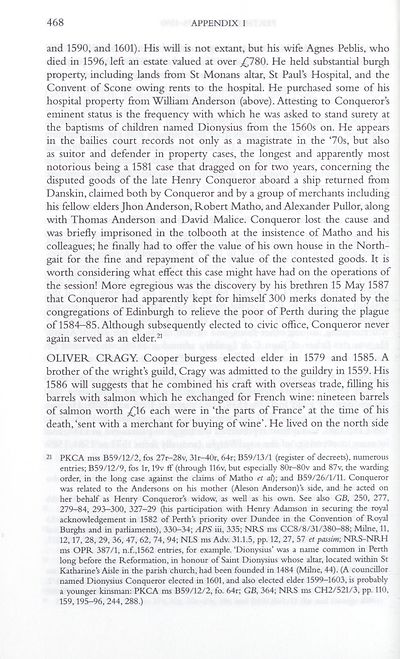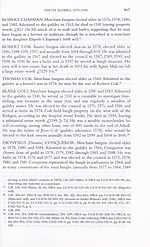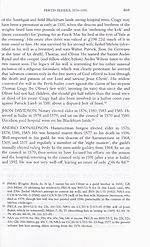Series 6 > Perth Kirk Session books, 1577-1590
(483) Page 468
Download files
Complete book:
Individual page:
Thumbnail gallery: Grid view | List view

468
APPENDIX I
and 1590, and 1601). His will is not extant, but his wife Agnes Peblis, who
died in 1596, left an estate valued at over ,£780. He held substantial burgh
property, including lands from St Monans altar, St Paul’s Hospital, and the
Convent of Scone owing rents to the hospital. He purchased some of his
hospital property from William Anderson (above). Attesting to Conqueror’s
eminent status is the frequency with which he was asked to stand surety at
the baptisms of children named Dionysius from the 1560s on. He appears
in the bailies court records not only as a magistrate in the ‘70s, but also
as suitor and defender in property cases, the longest and apparendy most
notorious being a 1581 case that dragged on for two years, concerning the
disputed goods of the late Henry Conqueror aboard a ship returned from
Danskin, claimed both by Conqueror and by a group of merchants including
his fellow elders Jhon Anderson, Robert Matho, and Alexander Pullor, along
with Thomas Anderson and David Malice. Conqueror lost the cause and
was briefly imprisoned in the tolbooth at the insistence of Matho and his
colleagues; he finally had to offer the value of his own house in the North-
gait for the fine and repayment of the value of the contested goods. It is
worth considering what effect this case might have had on the operations of
the session! More egregious was the discovery by his brethren 15 May 1587
that Conqueror had apparendy kept for himself 300 merks donated by the
congregations of Edinburgh to reheve the poor of Perth during the plague
of 1584-85. Although subsequendy elected to civic office, Conqueror never
again served as an elder.21
OLIVER CRAGY. Cooper burgess elected elder in 1579 and 1585. A
brother of the wright’s guild, Cragy was admitted to the guildry in 1559. His
1586 will suggests that he combined his craft with overseas trade, filling his
barrels with salmon which he exchanged for French wine: nineteen barrels
of salmon worth ,£16 each were in ‘the parts of France’ at the time of his
death, ‘sent with a merchant for buying of wine’. He lived on the north side
21 PKCA mss B59/12/2, fos 27r-28v, 31r-40r, 64r; B59/13/1 (register of decreets), numerous
entries; B59/12/9, fos lr, 19v IF (through 116v, but especially 80r-80v and 87v, the warding
order, in the long case against the claims of Matho el at)-, and B59/26/1/11. Conqueror
was related to the Andersens on his mother (Aleson Anderson)’s side, and he acted on
her behalf as Henry Conqueror’s widow, as well as his own. See also GB, 250, 277,
279-84, 293-300, 327-29 (his participation with Henry Adamson in securing the royal
acknowledgement in 1582 of Perth’s priority over Dundee in the Convention of Royal
Burghs and in parhaments), 330-34; APS iii, 335; NRS ms CC8/8/31/380-88; Milne, 11,
12,17, 28, 29, 36, 47, 62, 74, 94; NLS ms Adv. 31.1.5, pp. 12, 27, 57 et passim-, NRS-NRH
ms OPR 387/1, n.f.,1562 entries, for example. ‘Dionysius’ was a name common in Perth
long before the Reformation, in honour of Saint Dionysius whose altar, located within St
Katharine’s Aisle in the parish church, had been founded in 1484 (Milne, 44). (A councillor
named Dionysius Conqueror elected in 1601, and also elected elder 1599-1603, is probably
a younger kinsman: PKCA ms B59/12/2, fo. 64r; GB, 364; NRS ms CH2/521/3, pp. 110,
159,195-96, 244, 288.)
APPENDIX I
and 1590, and 1601). His will is not extant, but his wife Agnes Peblis, who
died in 1596, left an estate valued at over ,£780. He held substantial burgh
property, including lands from St Monans altar, St Paul’s Hospital, and the
Convent of Scone owing rents to the hospital. He purchased some of his
hospital property from William Anderson (above). Attesting to Conqueror’s
eminent status is the frequency with which he was asked to stand surety at
the baptisms of children named Dionysius from the 1560s on. He appears
in the bailies court records not only as a magistrate in the ‘70s, but also
as suitor and defender in property cases, the longest and apparendy most
notorious being a 1581 case that dragged on for two years, concerning the
disputed goods of the late Henry Conqueror aboard a ship returned from
Danskin, claimed both by Conqueror and by a group of merchants including
his fellow elders Jhon Anderson, Robert Matho, and Alexander Pullor, along
with Thomas Anderson and David Malice. Conqueror lost the cause and
was briefly imprisoned in the tolbooth at the insistence of Matho and his
colleagues; he finally had to offer the value of his own house in the North-
gait for the fine and repayment of the value of the contested goods. It is
worth considering what effect this case might have had on the operations of
the session! More egregious was the discovery by his brethren 15 May 1587
that Conqueror had apparendy kept for himself 300 merks donated by the
congregations of Edinburgh to reheve the poor of Perth during the plague
of 1584-85. Although subsequendy elected to civic office, Conqueror never
again served as an elder.21
OLIVER CRAGY. Cooper burgess elected elder in 1579 and 1585. A
brother of the wright’s guild, Cragy was admitted to the guildry in 1559. His
1586 will suggests that he combined his craft with overseas trade, filling his
barrels with salmon which he exchanged for French wine: nineteen barrels
of salmon worth ,£16 each were in ‘the parts of France’ at the time of his
death, ‘sent with a merchant for buying of wine’. He lived on the north side
21 PKCA mss B59/12/2, fos 27r-28v, 31r-40r, 64r; B59/13/1 (register of decreets), numerous
entries; B59/12/9, fos lr, 19v IF (through 116v, but especially 80r-80v and 87v, the warding
order, in the long case against the claims of Matho el at)-, and B59/26/1/11. Conqueror
was related to the Andersens on his mother (Aleson Anderson)’s side, and he acted on
her behalf as Henry Conqueror’s widow, as well as his own. See also GB, 250, 277,
279-84, 293-300, 327-29 (his participation with Henry Adamson in securing the royal
acknowledgement in 1582 of Perth’s priority over Dundee in the Convention of Royal
Burghs and in parhaments), 330-34; APS iii, 335; NRS ms CC8/8/31/380-88; Milne, 11,
12,17, 28, 29, 36, 47, 62, 74, 94; NLS ms Adv. 31.1.5, pp. 12, 27, 57 et passim-, NRS-NRH
ms OPR 387/1, n.f.,1562 entries, for example. ‘Dionysius’ was a name common in Perth
long before the Reformation, in honour of Saint Dionysius whose altar, located within St
Katharine’s Aisle in the parish church, had been founded in 1484 (Milne, 44). (A councillor
named Dionysius Conqueror elected in 1601, and also elected elder 1599-1603, is probably
a younger kinsman: PKCA ms B59/12/2, fo. 64r; GB, 364; NRS ms CH2/521/3, pp. 110,
159,195-96, 244, 288.)
Set display mode to:
![]() Universal Viewer |
Universal Viewer | ![]() Mirador |
Large image | Transcription
Mirador |
Large image | Transcription
Images and transcriptions on this page, including medium image downloads, may be used under the Creative Commons Attribution 4.0 International Licence unless otherwise stated. ![]()
| Scottish History Society volumes > Series 6 > Perth Kirk Session books, 1577-1590 > (483) Page 468 |
|---|
| Permanent URL | https://digital.nls.uk/127286433 |
|---|
| Description | Over 180 volumes, published by the Scottish History Society, containing original sources on Scotland's history and people. With a wide range of subjects, the books collectively cover all periods from the 12th to 20th centuries, and reflect changing trends in Scottish history. Sources are accompanied by scholarly interpretation, references and bibliographies. Volumes are usually published annually, and more digitised volumes will be added as they become available. |
|---|


